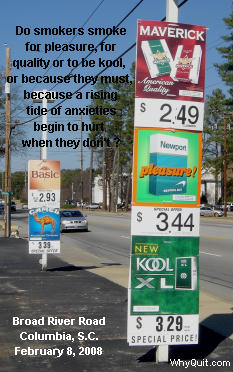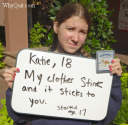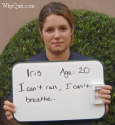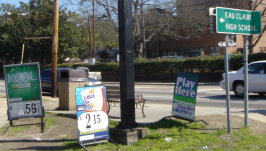City and County Council Inaction
Hand Youth to Nicotine Industry
 A rash of recent studies declare the insanity of city and county councils continuing to allow nicotine addiction industry marketing to transform neighborhood stores into subliminal child and teen brainwashing centers. Local elected leaders continue to act as though students are immune from the cumulative weight of thousands of invitations begging them to give nicotine a try, as though experimenting a few times with cigarettes or oral tobacco is normal, expected and can't hurt.
A rash of recent studies declare the insanity of city and county councils continuing to allow nicotine addiction industry marketing to transform neighborhood stores into subliminal child and teen brainwashing centers. Local elected leaders continue to act as though students are immune from the cumulative weight of thousands of invitations begging them to give nicotine a try, as though experimenting a few times with cigarettes or oral tobacco is normal, expected and can't hurt.
On June 22, 2009, Congress passed and the President signed "feel good," do nothing legislation called the Family Smoking Prevention Act. The Act does vastly more harm than good. One of the few good things it does is remind local government that youth dependency prevention is local government's responsibility. Still, an entire season has passed during which city and county councils across the nation have largely ignored ongoing tobacco industry youth harvesting.
Youth Nicotine Dependency Symptom Onset
According to the American Psychiatric Association, nicotine addiction reflects a loss of control, an inability to stop. Emerging research suggests that onset of the process leading to full-blown chemical dependency is immediate and escalating in a frightening percentage of adolescents.
 The exact moment of loss of control, freewill and autonomy reflects a threshold that appears to vary widely from student to student. Almost immediately in a significant percentage of youth, the mind's priorities teachers, its dopamine reward and insula anxiety pathways, develop an insatiable appetite for stimulation by nicotine. The frequency of neuro-chemical
rewards and beatings gradually increase as nicotine's presence quickly rewires the brain by increasing the number of nicotinic-type acetylcholine receptors in multiple regions, a process known as up-regulation.
The exact moment of loss of control, freewill and autonomy reflects a threshold that appears to vary widely from student to student. Almost immediately in a significant percentage of youth, the mind's priorities teachers, its dopamine reward and insula anxiety pathways, develop an insatiable appetite for stimulation by nicotine. The frequency of neuro-chemical
rewards and beatings gradually increase as nicotine's presence quickly rewires the brain by increasing the number of nicotinic-type acetylcholine receptors in multiple regions, a process known as up-regulation.
Ongoing up-regulation increases tolerance to nicotine while diminishing natural sensitivities. Like a dog chasing its tail, students feel compelled to gradually escalate nicotine intake in order to obtain the previously remembered level of dopamine pathway stimulation.
Self-awareness almost never occurs that the mind's priorities teacher, its pay attention circuitry, is in the process of assigning nicotine a survival instinct priority that's on a par with food and water. Instead, eventually too much time is allowed to pass between nicotine feedings and the student senses their first urge or crave, commanding them to engage in nicotine replenishment.
What's most amazing about the dependency onset process, and should probably be considered a symptom, is how rapidly and completely durable nicotine-use dopamine memories bury all remaining memory of what life was like before nicotine took control. Slave to a stimulant that increases the heart rate by up to 17 beats per minute, ask the next smoker you see if they have any remaining memory of the calm and quiet mind they once called home. Ask them to try and recall what it was like to go day after day and not once think about wanting to smoke nicotine.
At some point in the loss of autonomy process the dependency threshold gets crossed. Once hooked, the student may experience an emotional anxiety train wreck when attempting to end nicotine use, as their dopamine deprived brain works vigorously to down-regulate receptor counts and restore natural sensitivities.
How often can a teenager smoke nicotine before losing control? A December 2007 study in Addictive Behaviors surveyed 29,984 New Zealand adolescent smokers and found diminished autonomy and control over smoking in 25% of students after smoking only one cigarette, in 35% after smoking 3 to 4, and in 93% after smoking 100 or more.
An August 2009 study in Addictive Behaviors surveyed 367 adolescent smokers in Massachusetts and found that 6% exhibited reduced autonomy and control after smoking a single cigarette, 9% after two cigarettes, 26% after 3 to 4, and 96% after 100 or more.
Now a September 17, 2009 study reports on a national U.S. survey that examined symptoms of nicotine dependence in 8,081 individuals age 12-21 who had smoked less than two years, who each reported smoking at least 1 cigarette in the past month. Among them, 55% were age 17 or under, 51% started smoking within the past year, and 81% were non-daily smokers.
The survey found that 42% exhibited loss of control over smoking after smoking a total of 1 to 3 cigarettes during the prior month. According to the authors, "one of the challenges faced by those on the forefront of adolescent smoking prevention is combating the widely held belief that only heavy daily smokers become dependent on nicotine." "Once adolescents have reached the point of smoking daily, most are likely to experience a substantial number of nicotine dependency symptoms regardless of the amount they smoke each day."
The study also found that among smokers smoking at least one cigarette during 21 to 29 days of each month, that 76% reported irritability after not smoking, 80% reported loss of smoking control, 79% reported that the amount they smoked had increased, 80% reported regularly smoking throughout the day, and 78% said that they smoked the same number of cigarettes from day to day.
These figures are consistent with a June 2005 study in the Journal of Pediatric Psychology which found that 86.8% of students who smoked nicotine at least once daily were already chemically dependent under DSM-IV nicotine dependency standards.
If a member of council, ask the next few smokers you see how old they were when they started and how long they planned on smoking. A 1989 USDHHS survey found that among high school seniors smoking 1 pack of cigarettes a day, that while less than 1 percent expected to be smoking in 5 years, that 5 years later 87 percent were still smoking. Among seniors smoking less than 1 cigarette a day at graduation, 42 percent were still smoking 5 years later.
They were horribly misled about both how easy it is to get hooked and how difficult it is to quit. Sadly, roughly half already know the cause of death that will be printed on their death certificates, certificates scheduled to be issued an average of 13.2 years early for males and 14.5 years early for females. Who's to blame? Which local government official had responsibly for insulating them from industry enslavement tactics and teaching them the truth?
Time for Local Leaders to Rise and Fight to Protect Youth

"WARNING: cigarettes are highly addictive - studies have shown that tobacco can be harder to quit than heroin or cocaine."
Clearly, experimentation with that first cigarette is far more gripping than previously recognized. The Surgeon General asserts that nicotine enslaves the same brain pathways as heroin and cocaine. The addiction warning on random Canadian cigarette packs reads:
According to the CDC, 3,900 youth age 12 to 17 are enticed to smoke their first cigarette each day, with approximately 1,000 become regular daily smokers. Frankly, the industry has no choice. Killing more than 400,000 customers annually, the tobacco industry is economically dependent upon chemical enslavement of youth replacements.
The industry knows that adults have little need or desire to look more adult, are increasingly less affected by peer pressure and have generally grown savvy to both how hard it is to quit and the ravages of smoking.
City and county councils across America have abrogated responsibly for protecting young, gullible and immature minds from a legal industry that, by economic necessity, must lure, entice and hook them. Sadly, evidence of local government's long history of reckless indifference is impossible to miss. Nationwide, 26% of high school students report current use of cigarettes, cigars or smokeless tobacco.
If heroin were no longer criminal, would council vote to allow or ban its sale? According to the U.S. Supreme Court, state and local governments have a right to say "no" to the sale of cigarettes. If heroin were legal, would council permit children inside stores where it was being marketed and sold? Would council permit its sale in residentially zoned districts? Would council require those selling it to obtain a license, with 100% of licensing fees (based upon annual sales) going toward youth dependency prevention and recovery programs?

The industry preys upon the fact that teens want to feel more adult. The massive yellow "We Card" signs were put there by America's leading cigarette maker and shout out to youth that smoking is an adult activity, a rite of passage into adulthood. Each store's large and colorful tobacco sales display is intended to create a facade that falsely shouts that adults can't wait to wake-up each morning and run down to the store to try another brand.
 Look closely at Newport "pleasure" store signs depicting smoking with a new found friend, while having the time of your life. What student doesn't want pleasure, new friends and good times? The industry is subconsciously preparing youth to want to experiment the first time their surroundings match Newport's subconscious brainwashing.
Look closely at Newport "pleasure" store signs depicting smoking with a new found friend, while having the time of your life. What student doesn't want pleasure, new friends and good times? The industry is subconsciously preparing youth to want to experiment the first time their surroundings match Newport's subconscious brainwashing.
Look closely at the tobacco marketing signs hanging above candy, pastry and chip racks inside neighborhood convenience stores. Do you really think they're hanging there by chance? Here in South Carolina roughly half of convenience stores are engaged in the practice. What subconscious message is delivered to youth when the industry associates cigarettes with candy?
Look at exterior store tobacco marketing signs that daily burn flavor, pleasure and adult activity tease imprints into the subconscious minds of children in passing school buses, automobiles and on sidewalks.
If you think the cumulative impact of being daily bombarded with invitations to smoke nicotine is minimal, I encourage you to watch a short Derren Brown subliminal advertising YouTube video clip. It shows how subconscious subliminal marketing can affect conscious behavior.
Is there any reason why council couldn't immediately amend its zoning ordinance to eliminate all exterior product marketing signs, except on the business's permanent marquee?
Section 203 of the new Family Smoking Prevention Act states that, "a State or locality may enact statutes and promulgate regulations, based on smoking and health, that take effect after the effective date of the Family Smoking Prevention and Tobacco Control Act, imposing specific bans or restrictions on the time, place, and manner, but not content, of the advertising or promotion of any cigarettes."
While Congress correctly acknowledges that commercial advertising enjoys first amendment free speech content protections, the U.S.Supreme Court has declared that false, deceptive or misleading tobacco advertising does not.
Regarding flavor and pleasure marketing messages, if 90% of smokers smoke because they are addicted and have to, because a rising tide of anxieties begin to hurt when they don't, then why hasn't the city or county attorney written stores commanding that all false advertising to the contrary be immediately removed? Why would council permit store marketing to teach children that smokers smoke for taste when all members of council are aware that there are zero taste buds inside human lungs, the place cigarette smoke is drawn and held?
 Council's ability to protect youth from a lifetime of chemical servitude to nicotine is limited only by its imagination and applicable state law. In fact, Section 916 of the new Family Smoking Prevention Act is entitled "Preservation of State and Local Authority" and reflects the student's last best hope that someone, somewhere will attempt to protect them from an industry hell-bent on leaving them with a drug addiction that's as real and permanent as alcoholism.
Council's ability to protect youth from a lifetime of chemical servitude to nicotine is limited only by its imagination and applicable state law. In fact, Section 916 of the new Family Smoking Prevention Act is entitled "Preservation of State and Local Authority" and reflects the student's last best hope that someone, somewhere will attempt to protect them from an industry hell-bent on leaving them with a drug addiction that's as real and permanent as alcoholism.
In punting responsibility for youth protection, Congress declares in Section 916 that ... "nothing in this chapter, or rules promulgated under this chapter, shall be construed to limit the authority of a ... State or political subdivision of a State ... to enact, adopt, promulgate, and enforce any law, rule, regulation, or other measure with respect to tobacco products that is in addition to, or more stringent than, requirements established under this chapter, including a law, rule, regulation, or other measure relating to or prohibiting the sale, distribution, possession, exposure to, access to, advertising and promotion of, or use of tobacco products by individuals of any age..."
Is it legal to give away free nicotine products in your city or county? What about buy one get one free deals? What's stopping council from ending the sale of .80 cent single cigars, a price the industry knows youth can readily afford, and again requiring that cigars be sold in minimum packs of five? What prevents council from passing an ordinance requiring that all movie theater movie advertising, including theater billboards, alert parents and youth to the presence of smoking scenes in all P, PG and PG-13 rated movies? How many high school 18-year-olds would no longer be able to purchase tobacco for underclassmen if the legal age to purchase nicotine products was raised to 19?
It's time for city and county councils across the land to rise up and move to protect youth from the influence of those who seek to enslave them. Consider an immediate test vote of where council now stands. Simply propose the erection of a billboard on a highly visible public lot that teaches youth a simple yet critical dependency prevention lesson such as, "Don't be fooled by tobacco industry pleasure and flavor advertising. Nicotine is highly addictive and enslaves the same brain pathways as heroin and cocaine. It may only take smoking or using oral nicotine products once or twice before your brain begins begging for more."
Congress, the President and Supreme Court have spoken. It's your job. Other than extremely watered-down cigarette pack health warnings, that should begin appearing by July 2010, don't expect help from Washington. They've handed youth protection to city and county council. Addiction research screams that the time for action is now.

















